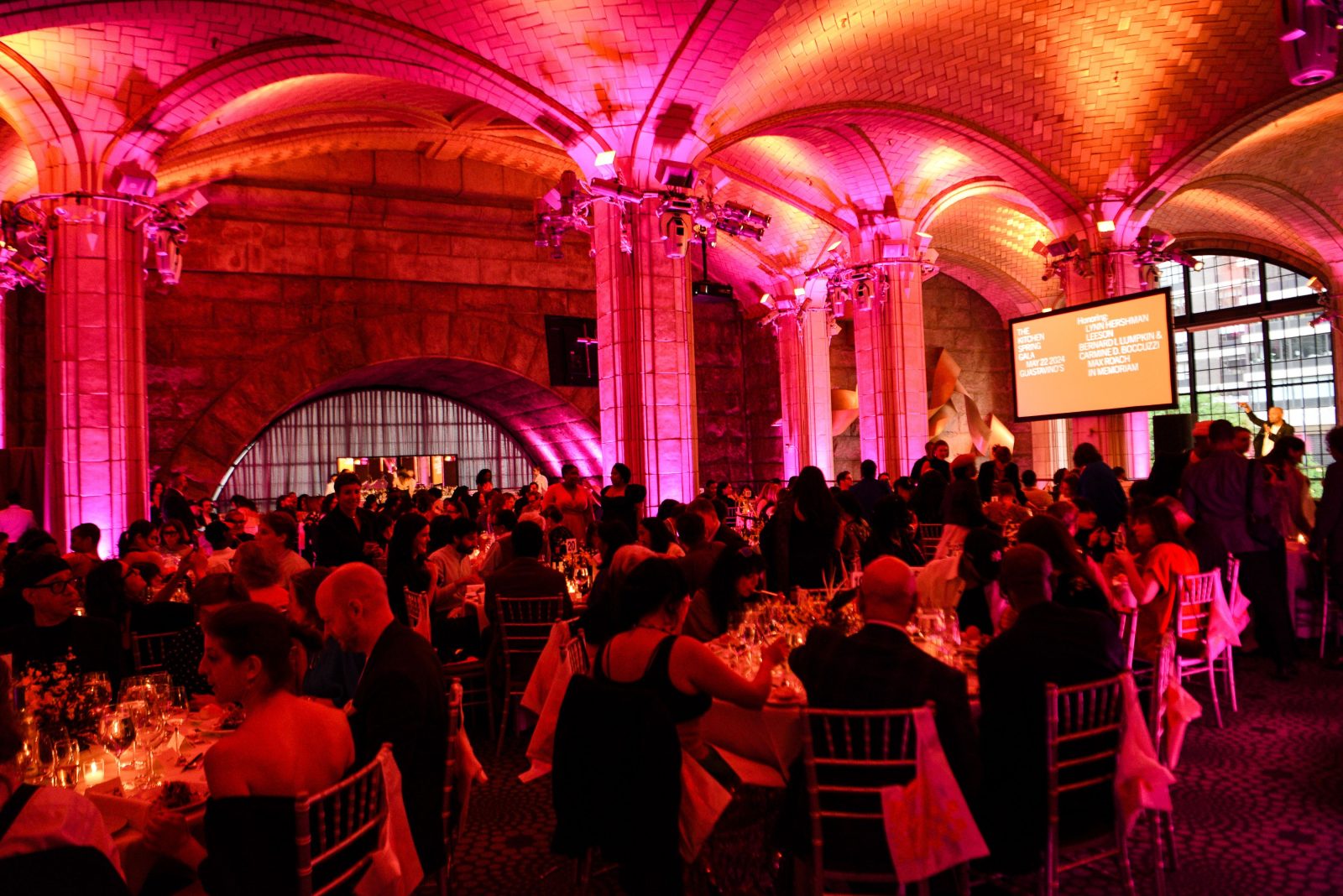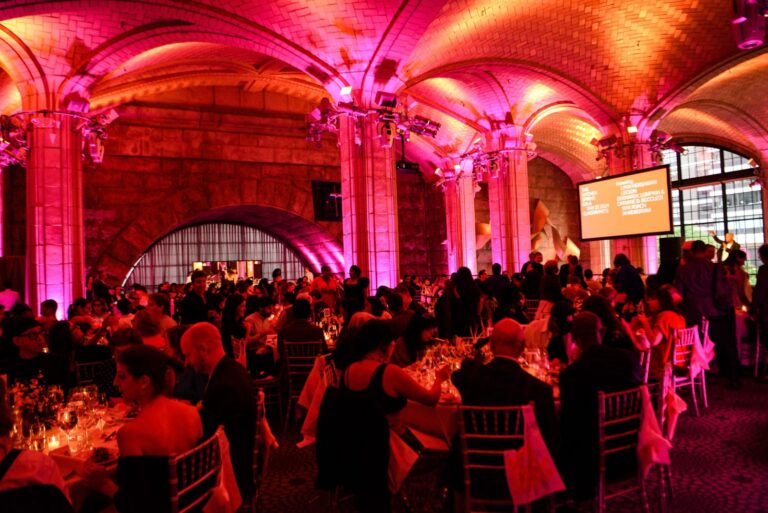As you'd expect from an event hosted by one of New York City's most forward-thinking institutions, The Kitchen's Spring Gala was full of excitement.
The event celebrated prolific couple Bernard I. Lumpkin and Carmine D. Bocczi, multimedia guru Lynn Hershman Leeson, and pioneering jazz musician Max Roach, offering a glimpse into the world that generations of artists have created with the support of The Kitchen. And it's a vast world!
Furthering The Kitchen’s mission of celebrating the arts and empowering radical and experimental thinking, the event’s chairs rounded out the evening with a performance from musician Eartheater, a multimedia sensory experience by Justin Allen, and speeches from Fab 5 Freddy, honorees, and members of The Kitchen community.
As we exchanged business cards and talked art, the true beauty of The Kitchen unfolded before our eyes: the sense of community that this cutting-edge art space has fostered for over 50 years was on full display in the camaraderie of those in attendance.
For me, this friendship began before I even set foot in the event.
As I reached the entrance of Guastavino's on the Upper East Side, I spotted a radiant woman in a red polka-dot outfit. “I'll copy you,” I told her. “Don't do that!” she jokingly shouted, and together we walked into The Kitchen's Spring Gala.
I learned that arts executive and my gracious host, Ruby Lerner, would be speaking later that evening in honor of artist Lynn Hershman Leeson. Despite having prepared hours for a speech that would last only a few minutes, Ruby confided in me that she was nervous at the last minute. I knew honoring an artist of Lynn Hershman Leeson's caliber would be no easy task. Her impactful lifetime contributions to the arts world transcend genre, medium, and form. I was excited to see how Ruby would craft a speech that would encapsulate such a wide range of contributions.

Not long after wishing Ruby well, I found myself embroiled in intense conversations with artists, patrons, and innovators. Through many of these conversations, it became clear that the future of the arts was a shared concern.
What is the future of art? “Experimental,” “industrial,” “extreme,” “diverse,” “kitchen” and other similar concepts were among the responses.
I believe all of these are true. The last statement just makes The Kitchen synonymous with the future of art itself. It is now a fact that the winners and The Kitchen are deeply rooted in both the past and future of art. Connecting the two through an enduring, passionate community is why I participated in this event.
The Kitchen is intentional about creating connections between families: “We want at least one The Kitchen artist at each table; we want to pack as many artists as possible into the space,” a member of The Kitchen's talented team told me.
I was lucky enough to sit next to one of the artists: Maren Hassinger, a veteran sculptor who was a recipient of The Kitchen's Spring Gala and recently had an exhibition at the Art Institute of Chicago called “This is How We Grow.” The exhibition featured two pieces made primarily from steel cables. shower, and Paradise reclaimed. Her specialty, I discovered, is using heavy industrial materials and composites to mimic natural elements and provide commentary on “how nature is.”
She told me about her craft and discussed how art and writing are complementary. We came to the conclusion that while she has a strong critical literacy, her visual literacy isn't as developed as it should be. Writing, in her words, often helps the viewer “digest” what they see. “I wish I could do it like you,” I said. “You can't,” she joked.
After she confessed her love of crime novels and I explained the plot of the new season, True Detective, Maren allowed me to ask her a few questions about her work.
“Do you title your work before, during, or after it is made?”
“Usually afterwards, but you never know what's going to happen,” she replied, as her studio assistant laughed.
“What does the future hold for you, Maren?”
“Well, there's the Getty,” she says humbly. Maren's future holds a return to her native Los Angeles, where the museum recently purchased her archive and will soon mount a major exhibit. Like her kitchen, Maren's future is full of elements of the past.

When the program began, it was clear that no one cared more about the future of the arts than Bernard I. Lumpkin and Carmine D. Bokci. As passionate advocates for investment in artists of color and artists from underserved communities, the two laureates have taken the issues into their own hands.
“Tonight we celebrate one of the world's leading new groundbreaking arts incubators… remembering the past, celebrating the present, and envisioning the future.” The two spoke about their “moments in the kitchen” and how these moments have influenced their approach to many projects that involve “young, talented, and black people.” The two remind us that hands-on work is necessary. They encourage collective action, calling on each individual to take responsibility for elevating and diversifying the arts world as we know it. The audience was undoubtedly touched by the words of this power couple.
Finally, we saw people in red polka dots walk up to the microphone, the program honored Lynn Hershman Leeson, and Ruby Lerner took the stage.
“Beyond the dizzying production volume, [Lynn Hershman Leeson] “Leeson has been involved in every important platform for artistic research from the late 20th century to the present,” the report said, highlighting the projects that brought Leeson to the forefront. Roberta Brightmore The personalities she creates, using driver's licenses, credit scores and mental health histories, are commentaries on personality. Deep Contact, It is the first artwork to use a touch screen. Women's Art Revolution,In a piece entitled “Leason's Decades of Contributions to the Feminist Art Movement,” Ruby expertly explains the breadth of Leeson's contributions and innovations.

“Try to keep up with her latest work on the cutting edge of art, biology and technology,” Ruby challenges. She says the road ahead is uncertain, but the only certainty, in her words, seems to be the continued evolution of art itself.
For Lynn Hershman Leeson, the honor couldn't have come sooner. “I've been trying to showcase my work for decades,” Leeson says. She credits a show she did at The Kitchen in 1990 with giving her the confidence to stick to her progressive vision. Her advice: “Faith in your vision and respect your instincts, even if it takes decades for people to understand what you're doing. Keep your sense of humor, and lastly, don't throw anything away.”
The highlight of the night was the performance shortly afterwards by New York natives EarthEater.
Without a spotlight and just her guitar, EarthEater kicked off her eagerly anticipated set with a string interlude. Before EarthEater launched into the seemingly impossible high notes that seemed effortless, she thanked the kitchen. It was within the walls of the kitchen that EarthEater discovered these notes and the true essence of her vocal talent. More specifically, she fondly stated, “I discovered that I could hold a really high note for a really long time.”

I wondered how an artist I admire for his unique provocativeness would be received by the crowds of elegant women and sophisticated men I saw as I surveyed the highboy and bistro tables at the gala's opening hour, and the handsome faces at the Met reminded me, “That's the beauty of 'The Kitchen.'” It was the element of the unexpected that he was referring to.
As the vocals of “Below the Clavicle” reached a crescendo, the audience's respect for the act matched only by the thunderous applause that followed. “The future of art is niche, micro-niche,” I wrote on my notepad.
The night was filled with highs and even higher highs, concluding with Fab 5 Freddie taking centre stage to reminisce about his past with his godfather Max Roach and the future paying tribute to the pair, rounding out the evening's discoveries.
His words need no further explanation.
“My father and Max Roach were childhood friends in the '40s and '50s when jazz was taking the world by storm. Max Roach was one of the leading figures in jazz. [of jazz] “I grew up listening to all these great stories, along with my contemporaries Miles Davis, Charlie Parker, and Dizzy Gillespie. But as I was growing up, this thing called hip hop happened, and I was there early on. I never set out to be a rapper, but I did some rhymes in the early days of hip hop.”
He continued, “Max came over to the house one day. He asked my dad what he was doing and he told me he was into rap. A few weeks later he came over and Max said he was surprised. I always thought he was just trying to please the younger guy. Shortly afterwards, a guy from The Kitchen met Max and told him about me.
At this point, I'm basically involved with disrupting the art world as we know it with some of my closest friends and partners in art crime like Jean-Michel Basquiat and Keith Haring. The idea came together to do a performance in a kitchen. I was like, my heart's going to explode, but I had to get up and think. So I got some amazing dancers together. I got two DJs and we did a two night performance in my kitchen. We called it “The Kitchen.” Estate Fresh. Thankfully, there were a few cameras installed in the kitchen that I didn't know about.
I have footage of this performance from decades ago, and I'm going to add some fried flavor to it and do a remix in my kitchen in October.”
Combining the revolutionary spirit of jazz legends with the innovative pulse of early hip hop, Fab 5 Freddy's examination highlights The Kitchen's role as a timeless incubator for artistic evolution. Another example of past and present colliding with the future, “Remix” is one to look forward to.
Sitting at the crowded afterparty, I had some time to think, and here's what I ultimately wrote:
The inspiring atmosphere of The Kitchen Spring Gala reminds us that art is not a solitary endeavor but a collective journey. There is always room for innovation at The Kitchen – past, present and future.


